Discover 15 hidden attractions, cool sights, and unusual things to do in Koblenz (Germany). Don't miss out on these must-see attractions: Middle Rhine, Deutsches Eck, and Schloss Stolzenfels. Also, be sure to include Electoral Palace in your itinerary.
Below, you can find the list of the most amazing places you should visit in Koblenz (Rhineland-Palatinate).
Table of Contents
Middle Rhine
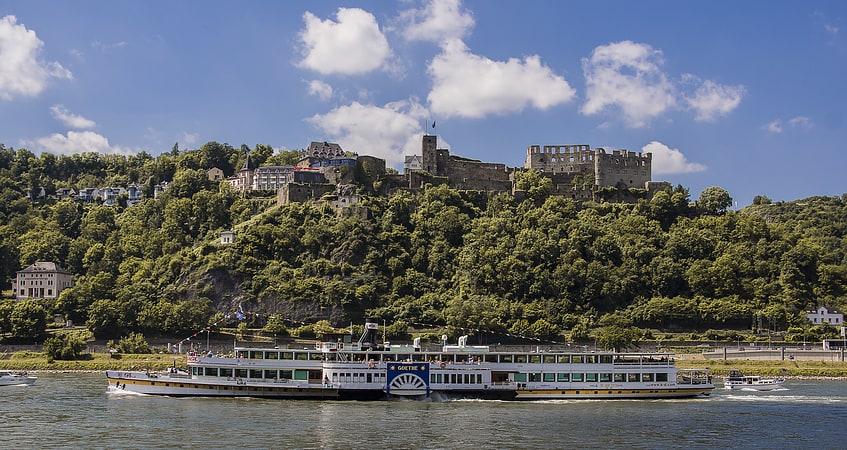
Also known as: Mittelrhein
Body of water. Between Bingen and Bonn, Germany, the river Rhine flows as the Middle Rhine through the Rhine Gorge, a formation created by erosion, which happened at about the same rate as an uplift in the region, leaving the river at about its original level, and the surrounding lands raised. This gorge is quite deep, about 130 metres from the top of the rocks down to the average water-line.
The "Middle Rhine" is one of four sections (High Rhine, Upper Rhine, Middle Rhine, Lower Rhine) of the river between Lake Constance and the North Sea. The upper half of the Middle Rhine (Rhine Gorge) from Bingen (Rhine-kilometer 526) to Koblenz (Rhine-kilometer 593) is a UNESCO World Heritage Site (2002) with more than 40 castles and fortresses from the Middle Ages and many wine-villages. The lower half from Koblenz (Rhine-kilometer 593) to Bonn (Rhine-kilometer 655) is famous for the formerly volcanic Siebengebirge with the Drachenfels volcano. Both parts together are known as "the romantic Rhine".
The Middle Rhine Valley has been a major tourist attraction since the 19th century. It is also home to some 450,000 people. The valley owes its special appearance to both its natural shape and human alterations. For two millennia, it has been one of the most important routes for cultural exchange between the Mediterranean region and northern Europe. Situated in the heart of Europe, it was sometimes a border and sometimes a bridge between different cultures. The history of the valley reflects the history of Western Europe. With its many outstanding monuments, its hills full of vines, its settlements crowded on the narrow river banks, and the rows of castles lined up on the hill tops, it is considered the epitome of the Rhine romanticism. It inspired Heinrich Heine to write his famous poem "Lorelei" and Richard Wagner to write his opera Götterdämmerung.
The vineyards along the Middle Rhine form the wine-growing region of the same name, see Mittelrhein (wine region).[1]
Deutsches Eck
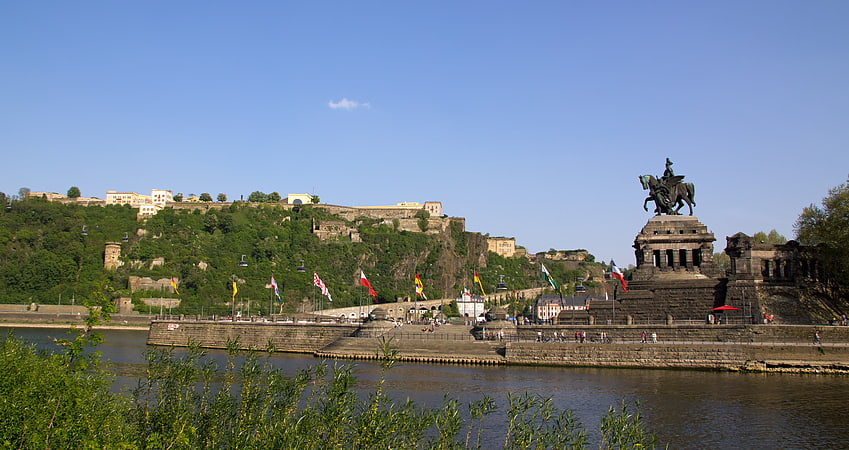
River confluence marked by giant statue. Deutsches Eck is the name of a headland in Koblenz, Germany, where the Mosel river joins the Rhine. Named after a local commandry of the Teutonic Order, it became known for a monumental equestrian statue of William I, first German Emperor, erected in 1897 in appreciation for his role in the unification of Germany. One of many Emperor William monuments raised in the Prussian Rhine Province, it was destroyed in World War II and only the plinth was preserved as a memorial. Following German reunification, a replica of the statue was erected on the pedestal after controversial discussions in 1993. It is today a Koblenz monument and a popular tourist destination.[2]
Address: Am Deutschen Eck, 56068 Koblenz
Schloss Stolzenfels

Romantic castle perched above Rhine. Stolzenfels Castle is a former medieval fortress castle turned into a palace, near Koblenz on the left bank of the Rhine, in the state of Rhineland-Palatinate, Germany. Stolzenfels was a ruined 13th-century castle, gifted to the Prussian Crownprince, Frederick William in 1823. He had it rebuilt as a 19th-century palace in Gothic Revival style. Today, it is part of the UNESCO World Heritage Site Upper Middle Rhine Valley.[3]
Address: Am Schlossweg 2, 56075 Koblenz
Electoral Palace
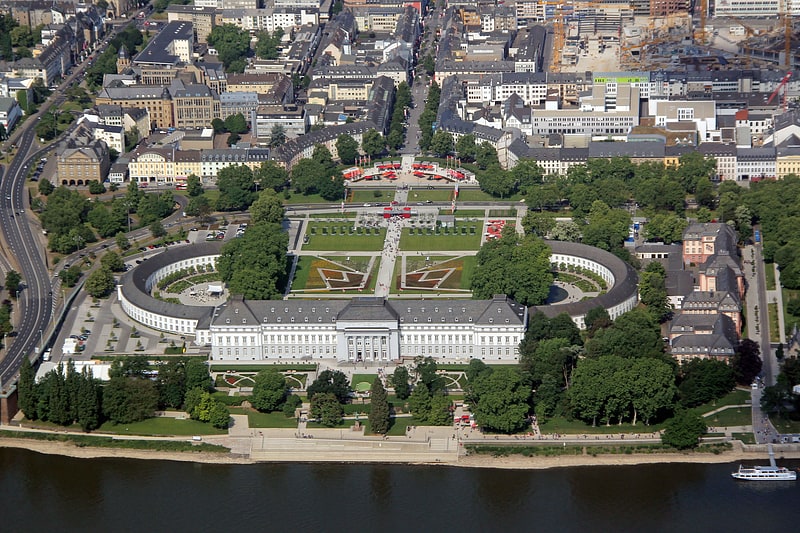
Also known as: Kurfürstliches Schloss
Majestic palace on manicured grounds. The Electoral Palace in Koblenz, was the residence of the last Archbishop and Elector of Trier, Clemens Wenceslaus of Saxony, who commissioned the building in the late 18th century. In the mid-19th century, the Prussian Crown Prince had his official residence there during his years as military governor of the Rhine Province and the Province of Westphalia. It now houses various offices of the federal government.
The Electoral Palace is one of the most important examples of the early French neoclassical great house in Southwestern Germany, and with Schloss Wilhelmshöhe in Kassel, the Prince Bishop's Palace in Münster and Ludwigsburg Palace, one of the last palaces built in Germany before the French Revolution. Since 2002, it has been part of the Rhine Gorge UNESCO World Heritage Site, and it is also a protected cultural property under the Hague Convention.[4]
Address: Neustadt 24, 56068 Koblenz
Festung Ehrenbreitstein
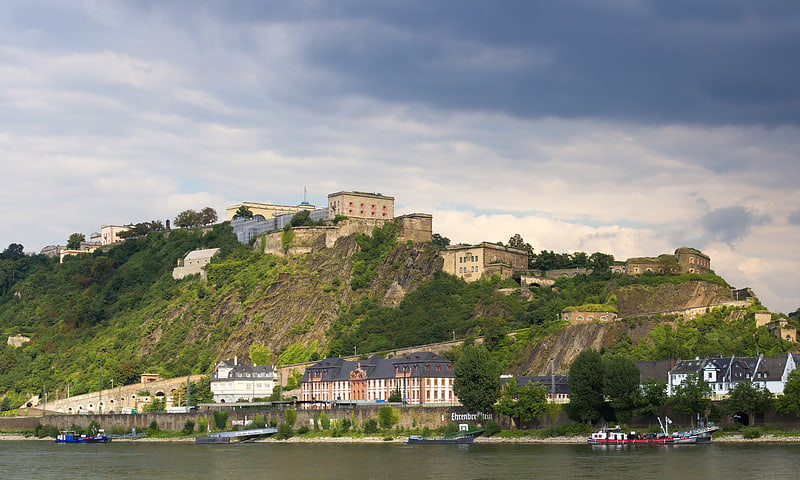
Elevated 19th-century fortress and museum. Ehrenbreitstein Fortress is a fortress in the German state of Rhineland-Palatinate, on the east bank of the Rhine where it is joined by the Moselle, overlooking the town of Koblenz.
Occupying the position of an earlier fortress destroyed by the French in 1801, it was built as the backbone of the regional fortification system, Festung Koblenz, by Prussia between 1817 and 1828 and guarded the middle Rhine region, an area that had been invaded by French troops repeatedly before. The Prussian fortress was never attacked.
Since 2002, Ehrenbreitstein has been part of the UNESCO World Heritage Site Upper Middle Rhine Valley.[5]
Address: Festung Ehrenbreitstein 1, 56077 Koblenz
Basilica of St. Castor
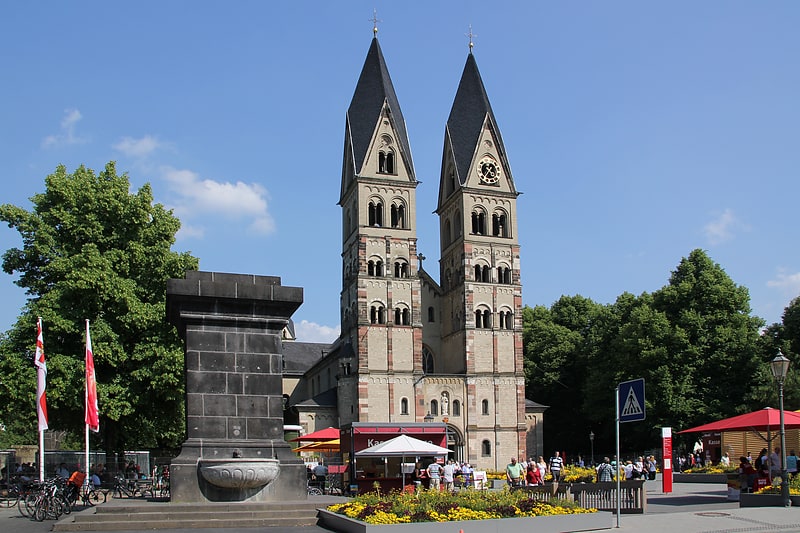
Also known as: St. Kastor
Historic church in the Romanesque style. The Basilica of St. Castor is the oldest church in Koblenz in the German state of Rhineland Palatinate. It is located near Deutsches Eck at the confluence of the Rhine and the Moselle. A fountain called Kastorbrunnen was built in front of the basilica during Napoleon’s invasion of Russia in 1812. Pope John Paul II raised St. Castor to a basilica minor on 30 July 1991. This church is worth seeing for the historical events that have occurred in it, its extensive Romanesque construction and its largely traditional furnishings.
Since 2002, the Basilica of St. Castor has been part of the UNESCO World Heritage cultural landscape of the Upper Middle Rhine Valley. In addition, it is a cultural property protected under the Hague Convention.[6]
Address: Kastorhof 4, 56068 Koblenz
Seilbahn Koblenz
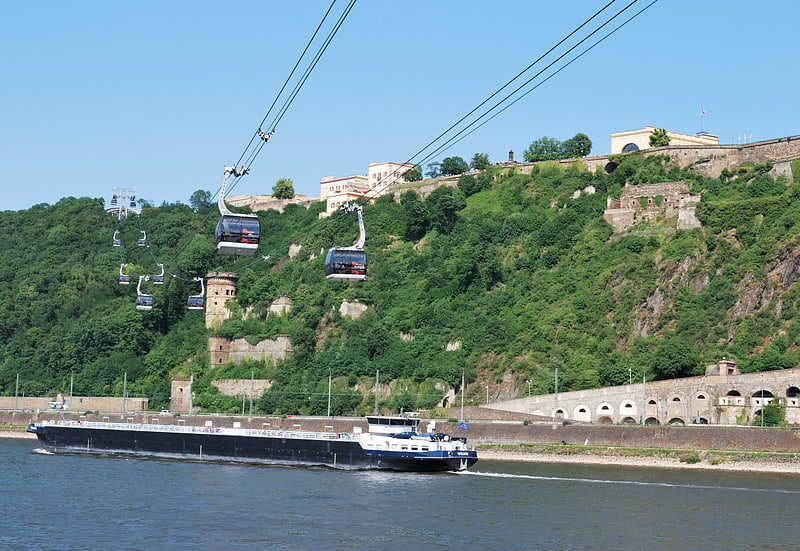
Gondola lift station in Koblenz, Germany. The Koblenz cable car is an aerial lift that was opened in 2010 in Koblenz, Germany for the Bundesgartenschau the following year. It connects the banks of the river Rhine and the hill plateau next to Ehrenbreitstein Fortress. The cable car system has an 890m length and elevates 112m.
The gondola system has an hourly capacity of 7600 people, the most for any such a ride in the world. It operates usually between April and October of a given year. Its construction and operation is in control by an Austrian company specialized in such rides, the Doppelmayr Gruppe.[7]
Kastorbrunnen
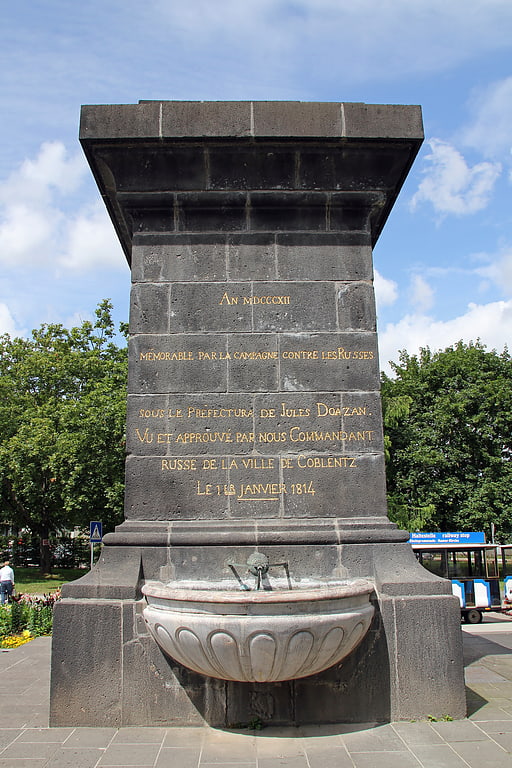
Fountain in Koblenz, Germany. The Kastorbrunnen in the forecourt of the Basilica of St. Kastor in Koblenz, Rhineland-Palatinate, Germany, is a curious testimony of the Napoleonic Wars. The fountain, built in 1812, was connected to the first aqueduct of the Elector Palatine.[8]
Old Castle

Also known as: Alte Burg
Archive in Koblenz, Germany. The Old Castle was a former Elector-owned, substantial water castle in the German city of Koblenz, incepted in the 13th century. It is today reduced to the later Burghaus; which houses the city archives. It sits on tall foundations and has a tall, black slate roof with further floors in the attic and two small cupolas. The lowland castle abutted the remaining building in the old town quarter. The castle house stands tall, next to the Moselle's right-bank towpath downstream of the strategic Baldwin Bridge built in 1342. The bridge, much-repaired, remains intact.[9]
Address: Burgstr. 1, 56068 Koblenz
DB Museum
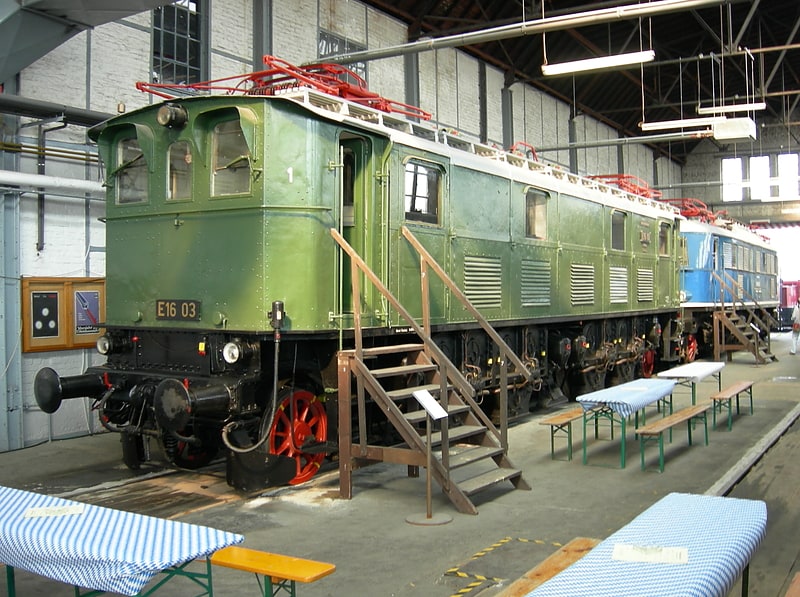
Museum in Koblenz, Germany. The DB Museum in Koblenz was opened on 21 April 2001 as the first remote site of the Nuremberg Transport Museum. It is run by volunteer workers as part of the Stiftung Bahn-Sozialwerk, a kind of railway workers social service organisation, and has its origins in a BSW's 'Group for the Preservation of Historical Railway Vehicles' at Koblenz.[10]
Address: Schönbornsluster Str. 14, 56070 Koblenz
German Federal Archives
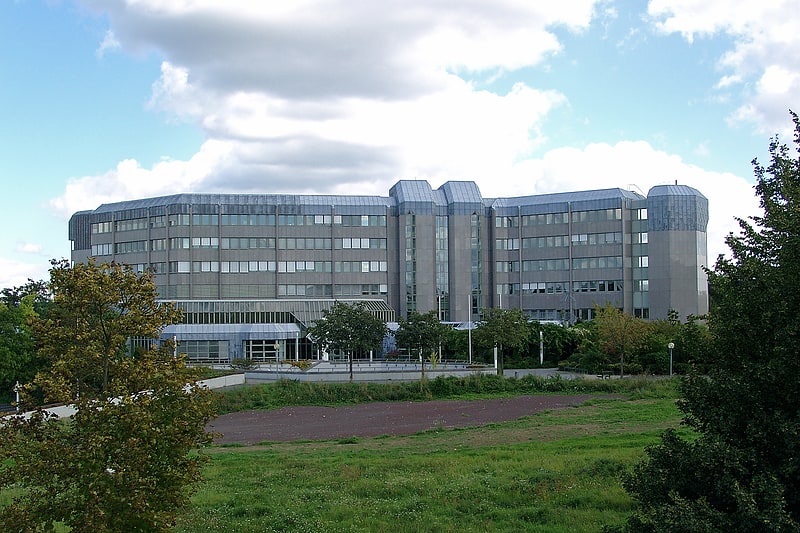
Also known as: Bundesarchiv
The German Federal Archives or Bundesarchiv are the National Archives of Germany. They were established at the current location in Koblenz in 1952.
They are subordinated to the Federal Commissioner for Culture and the Media (Claudia Roth since 2021) under the German Chancellery, and before 1998, to the Federal Ministry of the Interior.
On 6 December 2008, the Archives donated 100,000 photos to the public, by making them accessible via Wikimedia Commons.[11]
Address: 1 Potsdamer Straße, Koblenz
Theater Koblenz

Theatre in Koblenz, Germany. The Theater Koblenz is a multi-arts theatre with its own ensembles for drama, music theatre, puppetry and ballet located in Koblenz, Germany. It has about 190 permanent employees from 22 nations and offers 500 seats in a theatre building from the 18th century not far from the Electoral Palace. The manager until the end of the 2024/2025 season is Markus Dietze. Venues include the Theater am Deinhardplatz, rehearsal stages 2 and 4 as well as the Festung Ehrenbreitstein for the summer performances. In addition, the theatre participated in the Koblenz Fortress Plays for several years. In the 2009/2010 season, it was renamed from Theater der Stadt Koblenz to its current name.
Since 1970, the Clemensbrunnen has stood on Deinhardplatz in front of the theatre.[12]
Address: 5 Clemensstraße, Koblenz
Baldwin Bridge

Also known as: Balduinbrücke
Arch bridge in Koblenz, Germany. The Baldwin Bridge is a stone arch bridge over the Moselle in Koblenz, Germany. It is the oldest surviving bridge in the city and was built in the 14th century under Archbishop Baldwin of Luxembourg.[13]
Stadion Oberwerth
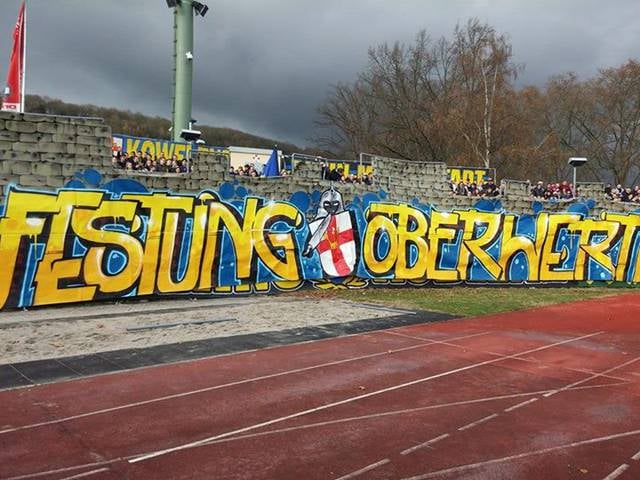
Stadium in Koblenz, Germany. Stadion Oberwerth is a multi-use stadium in Koblenz, Germany, originally built in 1920. It is currently mostly used for football matches and is the home stadium of TuS Koblenz. TuS Koblenz is playing the 2015/16 season in the fourth German tier, the Regionalliga Südwest. The stadium has a total capacity of 9,500 people including 2000 seats.[14]
Address: Jupp-Gauchel-Straße 10, 56075 Koblenz
Kühkopf
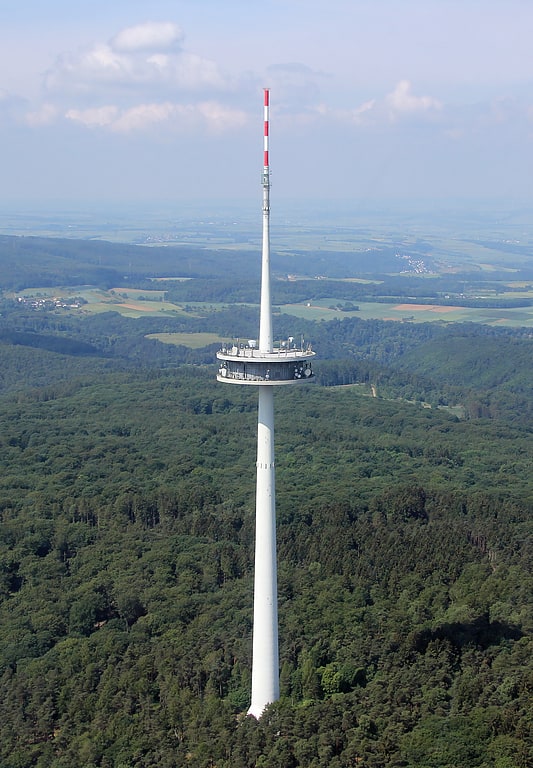
Also known as: Fernmeldeturm Koblenz
Tower in Koblenz, Germany. Fernmeldeturm Koblenz is a free standing telecommunications tower on the mountain Kühkopf near Koblenz, Germany. It was built between 1972 and 1976. The Fernmeldeturm Kühkopf is 260.7 m high and not accessible to visitors.[15]